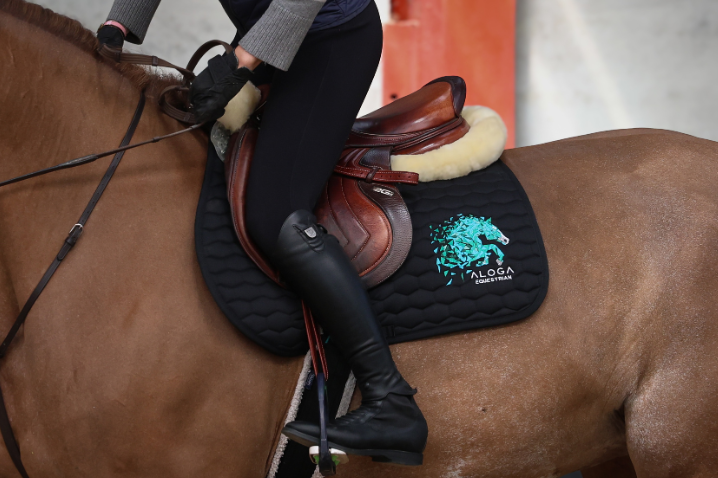Im Januar beginnen viele von uns, Pferde, die möglicherweise einen Teil des Winters pausiert haben, wieder in den Arbeitsalltag einzugliedern. Bei der Wiedereingliederung eines Pferdes nach einer Pause ist es wichtig, langsam und stetig vorzugehen. Wir geben Ihnen Insider-Tipps, wie Sie die Rückkehr Ihres Pferdes in den Arbeitsalltag planen und so Wohlbefinden und Fitness gewährleisten.
Beurteilen Sie den Zustand und das Zaumzeug Ihres Pferdes

Manche Pferde neigen nach einer Auszeit dazu, an Fitness zu verlieren, während andere aufgrund der längeren Ausfallzeiten an Gewicht zunehmen. Unabhängig davon, ob Ihr Pferd während der Pause auf der Weide war oder im Stall stand, empfehlen wir Ihnen, zunächst einen Gesamtzustandscheck durchzuführen. Beginnen Sie mit einer visuellen Beurteilung des Körpers, des Fells und der Vitalfunktionen Ihres Pferdes. Achten Sie genau auf seine Beine, seinen Rücken und seinen allgemeinen Körperzustand. Hat es ab- oder zugenommen? Reagiert es auf Druck, wenn man es an Rücken, Beinen oder Körper berührt? Gibt es neue Beulen oder Schwellungen? Wenn die Antwort auf eine dieser Untersuchungen „Ja“ lautet, sollten Sie einen Termin bei Ihrem Tierarzt oder Physiotherapeuten vereinbaren, um die Ursachen zu finden und sicherzustellen, dass sich neue Probleme nicht verschlimmern. Bei Gewichtsverlust oder -zunahme kann ein Gespräch mit einem Pferdeernährungsberater vor Ort helfen, einen Fütterungsplan zu erstellen, der auf die Rückkehr Ihres Pferdes ins Arbeitsleben abgestimmt ist.
Darüber hinaus ist es immer sinnvoll, die Passform des Zaumzeugs Ihres Pferdes zu überprüfen, insbesondere wenn Sie eine Veränderung seines körperlichen Zustands bemerkt haben. In manchen Fällen kann ein Wechsel der Satteldecke oder des Sattelgurts ausreichen. Bei schwerwiegenderen Veränderungen kann ein Termin bei einem qualifizierten Sattler helfen, die notwendigen Änderungen zu ermitteln, um Ihrem Pferd eine bequeme Rückkehr ins Training zu ermöglichen und langfristigen Problemen vorzubeugen. Die A -Loga-Satteldecke wurde in Zusammenarbeit mit unseren Teamreitern entwickelt und besteht aus einem Baumwollmischgewebe, das eine hoch atmungsaktive und langlebige Decke ergibt. Mit einer stoßdämpfenden Polsterung zum Schutz ist sie eine hervorragende Wahl, wenn Sie Ihre Satteldeckensammlung in diesem Jahr erweitern möchten.
Langsam und stetig

Konzentrieren Sie sich zu Beginn auf leichte Übungen mit geringer Intensität, um die Gesundheit und das Wohlbefinden Ihres Pferdes zu überprüfen. Beginnen Sie mit leichter Bodenarbeit oder Ausritten, um die Fitness Ihres Pferdes zu beurteilen. Bauen Sie anschließend Intervalleinheiten im Schritt und Trab ein und steigern Sie Dauer und Intensität über einige Tage hinweg schrittweise. Steigungs- und Bergarbeit ist ebenfalls eine hervorragende Möglichkeit, die Fitness zu verbessern, sofern Ihnen entsprechendes Gelände in den ersten Wochen nach der Rückkehr ins Training zugänglich ist. Steigern Sie Dauer und Intensität schrittweise und führen Sie Galopparbeit über einige Wochen wieder ein. Sobald Ihr Pferd fit genug ist, um 30–40 Minuten konstant zu arbeiten, sorgen Sie für Abwechslung, indem Sie Ihre Trainingseinheiten abwechslungsreich gestalten. Integrieren Sie Stangenarbeit, um das Pferd wieder zu aktivieren und die Rumpfkraft zu stärken.
Überwachen Sie den Fortschritt und ruhen Sie sich nach Bedarf aus
Als Besitzer und Reiter können wir unsere Pferde oft am besten beurteilen. Daher ist es wichtig, ihnen zuzuhören und auf Anzeichen von Müdigkeit oder Unwohlsein zu achten. Sie signalisieren Ihnen, ob Sie zu viel fordern oder wann sie bereit für mehr sind. Ausreichende Abkühlungsphasen im Training helfen Ihrem Pferd, sich zu erholen und sein Fell zu trocknen. Das ist besonders an kalten Tagen wichtig, wenn das Pferd stark geschwitzt hat. Ein schnell trocknendes Tuch wie die Aloga Waffle Cooler nach dem Training leitet Feuchtigkeit effektiv aus dem Fell ab. Ruhetage sind ein wesentlicher Bestandteil des Fitnessprozesses. Sorgen Sie daher dafür, dass Ihr Pferd ein oder zwei Tage pro Woche eine Pause von der Arbeit bekommt. Dies fördert die Regeneration von Muskeln, Sehnen und Bändern und unterstützt den Kräftigungsprozess, der zu einem allgemeinen Fitnessniveau führt. Aktive Ruhepausen, wie Weidegang oder Weidegang, fördern sanfte Bewegung und fördern die Durchblutung, insbesondere der unteren Gliedmaßen, was den Lymphabfluss und die Regeneration in diesen Bereichen fördert.
Die Wiedereingliederung Ihres Pferdes in den Arbeitsalltag nach einer Pause ist ein schrittweiser Prozess, der Geduld, Zeit und Aufmerksamkeit erfordert. Beobachten Sie körperliche und verhaltensbezogene Veränderungen Ihres Pferdes, um die Dauer und die Art der Übungen zu bestimmen, die die Rückkehr in den Arbeitsalltag für Sie und Ihr Pferd so angenehm und produktiv wie möglich gestalten.

